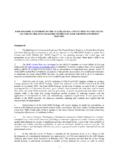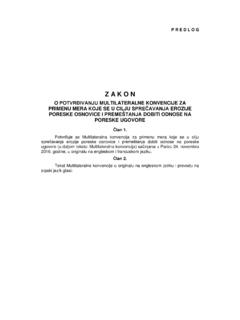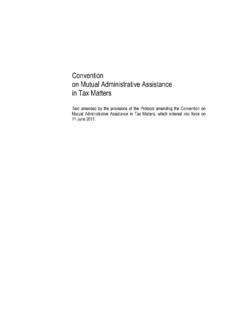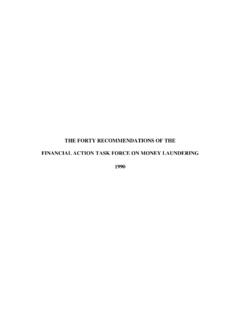Transcription of The global compact on refugees ZERO DRAFT - UNHCR
1 The global compact on refugees ZERO DRAFT (as at 31 January 2018) Paras I. Introduction .. 1-4 II. Comprehensive refugee response framework (CRRF) .. 5 III. Programme of action .. 6-75 A. Principal modalities for burden- and responsibility-sharing .. 12-34 1. National arrangements and global platform .. 14-16 2. Solidarity conferences .. 17-18 3. Additional funding and efficient use of resources .. 19-22 4. Regional organizations .. 23-24 5. A multi-stakeholder approach .. 25-32 6. Data and evidence .. 33-34 B. Support for the application of the CRRF .. 35-75 1. Reception and admission .. 36-47 Preparedness, contingency planning and early warning.
2 36 Immediate reception arrangements .. 37-38 Safety and security .. 39 Registration and documentation .. 40-41 Addressing specific needs .. 42-43 Identifying international protection needs .. 44-47 2. Meeting needs and supporting communities .. 48-64 Education .. 52-53 Jobs and livelihoods .. 54 Health .. 55-56 Accommodation, energy and natural resource management .. 57-59 Civil registries .. 60-62 Gender .. 63 Other areas of action .. 64 3. Solutions .. 65-75 Voluntary repatriation .. 66-68 Resettlement .. 69-71 Other pathways for admission to third countries.
3 72-73 Local solutions .. 74-75 IV. Follow-up arrangements .. 76-79 I. Introduction 1. Refugee issues are international in scope and nature, necessitating concerted action by all in a true spirit of international Building on the foundation of the international refugee protection regime,2 the global compact on refugees will strengthen international cooperation to ease pressures on the host countries involved; to enhance refugee self-reliance; to expand access to third-country solutions; and to support conditions in countries of origin for return in safety and The global compact addresses a perennial 1 Preamble, recital 4, 1951 Convention relating to the Status of refugees (United Nations, Treaty Series, vol.)
4 189, No. 2545). 2 The international refugee protection regime is a dynamic body of universal and regional refugee law and standards, founded on the 1951 Convention relating to the Status of refugees and the 1967 Protocol thereto (United Nations, Treaty Series, vol. 606, No. 8791), complemented by international human rights and humanitarian law instruments (such as article 14 of the Universal Declaration on Human Rights (A/RES/3/217 A)), and relevant regional instruments, such as the 1969 OAU Convention Governing the Specific Aspects of Refugee Problems in Africa (United Nations, Treaty Series, vol. 1001, No. 14691) and the 1984 Cartagena Declaration on refugees .
5 3 Para 18, Annex I, New York Declaration for refugees and Migrants (A/RES/71/1) (New York Declaration). 2 gap in the international system for the protection of refugees : the need for more predictable and equitable burden- and responsibility-sharing among States, together with other stakeholders. 2. The success of the global compact will ultimately hinge on how much progress is made in the following areas: (1) sustained international financial and other forms of support to refugees and host communities; (2) strengthened national refugee response capacity; (3) improved socio-economic conditions for refugees and host communities, notably women and girls; and (4) enhanced efforts to resolve protracted situations, resulting in increased prospects for durable solutions.
6 3. Based on a two-year process of engagement with States and consultations with other relevant stakeholders, and drawing upon early lessons learned from the application of the comprehensive refugee response framework (CRRF), the global compact seeks to transform the international community s approach to providing protection, assistance, and solutions for refugees and supporting host countries and communities. 4. The global compact on refugees consists of two parts: (i) the CRRF, as adopted by the United Nations General Assembly in the New York Declaration for refugees and Migrants (A/RES/71/1) (New York Declaration), Annex I; and (ii) the programme of action, which underpins the CRRF and facilitates its application.
7 II. Comprehensive refugee response framework (CRRF) 5. The first part of the global compact is the CRRF, as set out in the New York Declaration, Annex I. III. Programme of action 6. The second part of the global compact is the programme of action, as set out below. 7. The purpose of the programme of action is to facilitate the application of a comprehensive response in support of countries particularly affected by a large movement of refugees , a protracted situation, or other context,4 as may be appropriate. The programme of action envisages generic support measures that would be translated into mutually reinforcing arrangements, contextualized and adapted to the specifics of each situation at the country and/or regional level.
8 8. More specifically, this would result in: - a broadened base of sustainable support for refugees and host countries through the engagement of a wide array of relevant stakeholders; - stronger and more predictable humanitarian and development responses that are consistent with national development strategies and support sustainable development; - increased investments in building human capital and resilience through support to education and livelihood opportunities for host communities and refugees , pending the realization of durable solutions; and - strengthened focus on addressing root causes and planning for solutions, including voluntary repatriation and resettlement, from the onset of emergencies.
9 9. The programme of action is based on the recognition that humanitarian, development, and peace efforts are complementary and reinforce each other in order to: address the root causes of forced displacement; meet the needs of refugees and host communities; and realize durable solutions. It is in line with the sustainable development agenda5 and ongoing United Nations reforms in the areas of prevention, peace, security, development, and peacebuilding. 4 mixed situations involving refugees and migrants. 5 As set out in the 2030 Agenda for Sustainable Development and its 17 Sustainable Development Goals. 3 It also links to broader United Nations efforts to combat racism, discrimination, and xenophobia.
10 10. The programme of action invites engagement by States and other relevant stakeholders, including local authorities; international organizations within and outside the United Nations system; other development actors and international financial institutions; regional organizations; civil society, including faith-based organizations; academics and other experts; the private sector; media; and refugees themselves (hereinafter relevant stakeholders ).6 11. Age, gender, and diversity considerations will guide all aspects of the programme of action, informed by the imperatives of promoting gender equality and empowering women and girls, as well as by the best interests of the child.
















